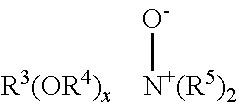[0006]According to a first aspect of the present invention, there is provided an automatic dishwashing detergent composition comprising an improved enzymatic system comprising an improved protease (a variant protease as described herein below) in combination with a low temperature amylase (as described herein below). The composition of the invention provides cleaning and finishing benefits across a wide range of temperatures, including low temperatures, improving the energy profile of the dishwashing process. Surprisingly, the composition of the invention allows for a more energy efficient dishwashing processes without compromising in cleaning and finishing.
[0007]The variant protease for use in the composition of the invention is a protease wherein the variations are made versus a protease that has at least 70%, preferably at least 90%, more preferably at least 95%, even more preferably at least 99% and especially 100% identity with the amino acid sequence of SEQ ID NO:1. Said variant protease comprises substitutions in one or more of the following positions: 32, 33, 48-54, 58-62, 94-107, 116, 123-133, 150, 152-156, 158-161, 164, 169, 175-186, 197, 198, 203-216 as compared with the protease in SEQ ID NO:1. Excellent results in terms of cleaning and finishing (including absence of spotting and filming and excellent shine) have been obtained when the variant protease comprises the following variations: G116V+S126L+P127Q+S128A.
[0031]In preferred embodiments, the composition comprises a high level of amylase, at least 0.2 mg of active amylase per gram of composition, preferably from about 0.2 to about 10, more preferably from about 0.25 to about 6, specially preferred from about 0.3 to about 4 mg of active amylase per gram of composition. It has been found that compositions comprising a high level of amylase help to prevent grit formation during the automatic dishwashing process and provide good cleaning and finishing results. Better results in terms of grit removal can be achieved when the composition comprises a lipase, thus in a preferred embodiment the composition of the invention comprise a lipase, preferably a lipase derived from the Humicola Lanuginosa wild -type that contains the mutations T231R and N233R. Compositions comprising Lipex® (Novozymes A / S, Bagsvaerd, Denmark) have been found particularly effective in terms of grit prevention.
[0032]The cleaning results can be further improved by adding a high level of protease to the composition. Thus, in further preferred embodiments, the composition comprises a high level of protease, in particular at least 1.5 mg of active protease per gram of composition. Preferred levels of protease in the compositions of the invention include from about 1.5 to about 10, more preferably from about 1.8 to about 5 and especially from about 2 to about 4 mg of active protease per grams of composition. The biodegradability of the compositions of the invention is further improved when a high level of enzyme is present. The high level of enzyme allows for a reduction on the level of non-biodegradable ingredients of the product and at the same time improves cleaning and finishing performance.
[0034]In preferred embodiments, the compositions of the invention reduce the particle size of the soil fragments and / or molecular weight as compared to that obtained with traditional detergent compositions. This facilitates the suspension of the soils in the wash liquor. Soil suspension can further be improved by an anti-redeposition agent. The anti-redeposition agent contributes to keep detached soils as individual entities in solution and prevents re-combination that can give rise to grit formation. These agents can also help to detach soils from the soiled surfaces. This in combination with soil suspension contributes to a more effective enzymatic cleaning and results in better shine and reduced filming and spotting on the washed items. Preferred anti-redeposition agents are non-ionic surfactants, in particular non-ionic surfactants having a phase inversion temperature (PIT) in the range of from about 40 to about 70° C. Compositions comprising non-ionic surfactants having a PIT in this temperature range provide very good cleaning. The anti-redeposition agent may also help the enzymes to get to the soiled substrates. The anti-redeposition agent seems to help with the cleaning during the main wash. Some of the anti-redeposition agent is carried over to the rinse cycle where it helps with sheeting thereby reducing / eliminating filming and spotting. Surfactants, having a PIT in the claimed range, present cleaning properties during the main wash and sheeting properties during the rinse. In other preferred embodiments the anti-redeposition agent is a non-ionic surfactant having a Draves wetting time (as measured using the standard method ISO 8022 under the following conditions; 3-g hook, 5-g cotton skein, 0.1% by weight aqueous solution at a temperature of 25° C.) of less than about 360 seconds, preferably less than 60 seconds.
[0037]In preferred embodiments the unit dose form is a water-soluble pouch (i.e., water-soluble film enveloping a detergent composition), preferably a multi-compartment pouch having a plurality of films forming a plurality of compartments. This configuration contributes to the flexibility and optimization of the composition. It allows for the separation and controlled release of different ingredients. Preferably one compartment contains a composition in solid form and another compartment contains a composition in liquid form.
 Login to View More
Login to View More 


